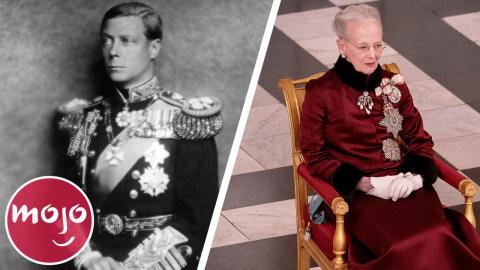Top 10 Most Controversial Times That Royals Abdicated the Throne

Margrethe II
At the very end of 2023, Margrethe II of Denmark announced her 2024 abdication from the throne, a position she had held since 1972. She pointed at her back surgery as one leading factor in becoming the first Danish monarch to willingly leave since 1146. Recent years haven’t been kind to Margrethe. After all, she caused controversy in 2022 by removing the royal titles of her grandchildren through her son Joachim. Meanwhile her husband, Prince Henrik, refused to be buried next to her after she didn’t award him the title of King Consort. Margrethe’s son took over, becoming Frederik X, which hasn’t pleased everyone. When photographs of the Queen’s eldest son with a Mexican socialite surfaced in November 2023, so too did allegations of an affair. There’s speculation this caused Margrethe to get Frederik in as King to save his marriage with Mary.
Charles X
Being a French monarch during the 1800s was a horrendous task. If you didn’t have Napoleon Bonaparte and his family overthrowing you, the citizens were starting revolutions. In 1824, Charles X succeeded Louis XVIII - his brother. Not long into his reign, the public turned on him. Charles believed he had a divine right to rule and began reinstating outdated royal traditions. This derailed the social progression in France as Charles became more authoritarian, infuriating many. In 1830, the July Revolution happened with the plan to overthrow Charles. While it only lasted three days, its effect was startling as the protesting crowds grew and fighting between them and the royalists broke out. In the end, Charles abdicated after losing the Chamber’s support and was exiled from France.
Louis XIX
When Charles X abdicated, the position passed to his eldest son, Louis Antoine, Duke of Angoulême, turning him into Louis XIX. However, within twenty minutes, he, too, had abdicated the throne, ultimately leading to Louis Philippe I officially picking up the crown. The Guinness World Records counts Louis XIX's very brief run as the shortest in history. When Charles signed the abdication document, he wanted to bypass Louis and pass the crown to his grandson, Henry, Duke of Bordeaux. For 20 minutes, he and Louis argued before the last Dauphin of France signed the document as well. However, the legitimacy of the brief reign is disputed by some historians.
Christina, Queen of Sweden
In 1632, Gustavus Adolphus was slain in battle. With that, his young daughter Christina became the Queen of Sweden under a regency before taking the crown fully in 1644 when she turned 18. Within four years, she helped end the Thirty Years’ War that had Protestants facing off against Catholics. Yet Christina drew the ire of the court with this unorthodox reign. She detested traditionally female activities, preferring the arts and sports, and announced she wouldn’t marry anyone or provide an heir. In 1651, after working 10 hours every day, Christina had a period of intense mental distress. That same year, the execution of a popular historiographer and her conversion to Catholicism were seemingly the final straws. In 1654, Christina announced her abdication and later moved to Rome, Italy.
Marie-Adélaïde, Grand Duchess of Luxembourg
In 1912, after the passing of William IV, the reign of his daughter, Marie-Adélaïde, began in Luxembourg. And it was a historical moment as she was the country’s first Grand Duchess regnant and the first woman to rule the country since 1780. Marie-Adélaïde quickly upset elected politicians by trying to change decisions. But when World War One broke out, that’s when her reign’s popularity tumbled dramatically. After initially protesting Germany’s invasion of Luxembourg, Marie-Adélaïde’s attitude appeared to change. Many believed she supported them. By the end of the war, Allied nations criticized Marie-Adélaïde’s actions. This led to her abdicating to her sister, Charlotte, in 1919, who restored faith in the monarch after a referendum. Marie-Adélaïde spent some time in an Italian convent before passing away in 1924.
Queen Liliʻuokalani
After the passing of her brother, Kalākaua, Liliʻuokalani ascended to the throne in Hawaii in 1891. And it was a turbulent time. In 1887, a constitution nicknamed the “Bayonet Constitution” was instigated to remove the monarchy’s power and hand it to a coalition of wealthy, white businessmen. In 1893, Liliʻuokalani tried to reinstall the royal power with a new constitution. A US military-supported coup d'état was successfully initiated, turning the nation into a republic. In 1895, after a failed attempt to restore Liliʻuokalani to the throne, she was arrested. To save her supporters, she abdicated from the throne. By 1898, the United States annexed Hawaii. Liliʻuokalani spent the rest of her days living in Honolulu before passing away in 1917.
Leopold III of Belgium
In 1934, Leopold III ascended to Belgium's throne. Within 5 years, World War Two began. While the Allied forces tried to convince Belgium to join them, the country refused, wanting to remain neutral. But in 1940, the Axis invaded Belgium. While the government fled, Leopold stayed to officially surrender to Germany, drawing the ire of Allied leaders and his government. When the Allies won, thus began what’s known as the “royal question,” as Leopold was exiled to Switzerland as his brother, Prince Charles, was regent in Belgium. People argued whether Leopold could continue the monarchy after his actions in the war. In 1950, he was allowed back into the country. However, widespread protesting and violence forced Leopold to abdicate in 1951, with the throne passing to his son.
Victor Emmanuel III of Italy
In 1900, Victor Emmanuel III became Italy’s king. In 1922, Benito Mussolini rose to power with fascism. To curb a potential civil war, Victor Emmanuel gave his support to Mussolini as he began a dictatorship, signing all sorts of authoritarian laws he was presented with. In 1940, Victor Emmanuel allowed Mussolini to join the Axis for World War Two. In 1943, he removed Mussolini from power and arranged an armistice with the Allies. However, afraid of a German invasion, Victor Emmanuel fled Rome, weakening his image even further. He then transferred his powers to his son, Umberto II. To save the monarchy, Victor Emmanuel also abdicated to his son in 1946 and exiled himself to Egypt. One month later, the Italian monarchy was abolished.
King Juan Carlos I of Spain
Top 20 Times Olympic Athletes Cheated
After nearly 40 years, the dictatorship of Francisco Franco ended with his passing in 1975. Shortly after, Juan Carlos I was crowned the king of Spain. He immediately got to work transitioning the country into a democracy. For this, Juan Carlos was extremely popular. Yet, in 2012, that all changed. As the country was in a financial crisis, Juan Carlos secretly went elephant hunting in Botswana. This, mixed with Juan Carlos’s daughter’s husband being involved in a corruption scandal, made his position untenable. In 2014, Juan Carlos abdicated the throne to his son, Felipe VI. In 2020, news of Juan Carlos being reportedly involved in a corruption scandal became public. So, he exiled himself to the United Arab Emirates. In 2022, the former monarch began visiting Spain.
King Edward VIII
Top 10 Most Controversial Royal Weddings
In January 1936, Edward VIII became king of the United Kingdom after his father, George V, passed away. He didn’t take to his new position very well, as he clashed with the government and broke royal customs. But the biggest scandal was his relationship with American socialite Wallis Simpson. Edward planned to marry Simpson. At the time, as Edward was the head of the Church of England, they didn’t allow divorcees with living ex-spouses to marry in church. This was an issue as Simpson was in the middle of divorcing her second husband. In December 1936, Edward chose to abdicate to his brother, George VI, so he could marry Simpson. But even afterward, the two found themselves in further controversy as they grew close to Nazi Germany.
Which world leader or leading politician had the most controversial resignation? Let us know below!



